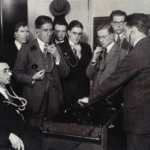Howard Fischer
Uppsala, Sweden
 |
| Doctors or medical students listening to their heartbeats using a multiple stethoscope. Photograph. Credit: Wellcome Collection. Attribution 4.0 International (CC BY 4.0) |
In order to study medicine, a future doctor needs motivation, some intelligence, a medical school, and the ability to pay for the education. Morton Thompson’s 1954 novel Not As a Stranger follows a young man through childhood, medical school, and beyond. A film based on the book was released in 1955, and both were popular successes. Peter Dans, MD, writes, “If I had to choose only one film for a seminar on movies and medicine, this would be it.”1
The main character is Lucas (Luke) Marsh, who has wanted to be a physician since childhood. As a boy he loved to follow the local doctor on housecalls. Against his parents’ wishes, Luke takes premedical classes and is admitted to medical school. These events take place in the 1920s, after the Flexner Report (1910) reforms of American medical education, so his premedical education was followed by a four-year course of medical studies. Luke visualizes “Medicine” with an uppercase “M.” It is his obsession. His roommate Al tells him, “You only want one thing in the world, really, and that’s to become a doctor.”2
Unfortunately for Luke, when the time comes to pay for his first year of medical school, he does not have the $600 (about $9,000 in today’s money) required. He learns that his alcoholic father has spent all of the small inheritance left to Luke by his mother. Historically, the $600 seems like a reasonably accurate sum. For comparison, medical school tuition at the University of Pennsylvania was $500 per year from 1930–1945.3
Luke pleads with the school bursar and gets a thirty-day extension to pay the fee. No loan company will touch someone without a job or collateral. He borrows all that his friends can (or will) give, which is just under $100. Desperation drives him to court the head nurse of the operating room, Kristina (Kris, Kristi) Hedvigsen. Kristi is a first-generation Swedish-American and a marvelously capable head nurse. She is also a bit socially awkward, speaks with an accent, and her grammar is not always correct. She is not his social equal, but she does have several thousand dollars saved up. Luke respects her skills but he does not love her. Still, he asks her to marry him: “He knew what he was doing. He knew what he had to do. He knew what he must have.”4
Kristi, on the other hand, loves Luke. The reader realizes that she knows he is marrying her for tuition money. She understands how important medicine is to him and wants to help. At the marriage license bureau he cannot fill in the part of the form that asks for the woman’s maiden name because he does not know how to spell it. The reader feels embarrassed and sad for Kristi, who is marrying someone disinterested in his future wife except for her bank account. They marry and he continues his education, becomes a physician, and goes into private practice. The marriage is ultimately unhappy and she asks him to leave. Later he fails to save a friend and colleague with an emergency surgery for a ruptured aortic aneurysm and realizes that no one can be perfect in the practice of medicine.
The way students finance their medical education has changed significantly over time. In the early 1960s, 31% of students borrowed money for their medical education, while 86% did so in the class of 2019. The class of 1999 finished school with a debt burden—not including undergraduate tuition debt—of $115,000,5 while the class of 2019 was in debt an average of $200,000.
At the intersection of medicine, money, and marriage, is the question of divorce. If one spouse helped the other in obtaining a degree or education that leads to “enhanced earning capability,” in a divorce the helping spouse is entitled to a percentage of the future earnings that the degree will confer upon the degree recipient. In one case where a wife put her husband through medical school, a divorce court awarded her $7,500 per month in alimony for life.6
It would seem that the financing of a medical education and the reasons for entering into marriage are both worthy points of reflection.
References
- Peter Dans, Doctors in the Movies: Boil the Water and Just Say Aah. Bloomington: Medi-Ed Press,2000. p 10.
- Morton Thompson. Not as a Stranger. New York: Charles Scribner’s Sons, 1954. p315.
- Mark Lloyd and Nicholas Heavens. Tuition and Mandated Fees, Room and Board, and Other Educational Costs at Penn. 1930-1939, 1940-1945. University Archives and Records Center, 2003.
- Thompson, “Not as,” p294.
- Ryan Greysen, Candice Chen, and Fitzhugh Mullan, “A History of Medical StudentDebt: Observations and Implications for the Future of Medical Education,” Acad Med 86, no. 7, (2011): 840-845.
- Patel v. Patel, Tenn. Ct. App. 2019
HOWARD FISCHER, MD, is a retired professor of Pediatrics at Wayne State University School of Medicine. He has co-authored a textbook on child abuse and neglect. He has always been interested in the links between literature and medicine and has also published some articles on his interpretations of Bob Dylan’s lyrics.

Leave a Reply